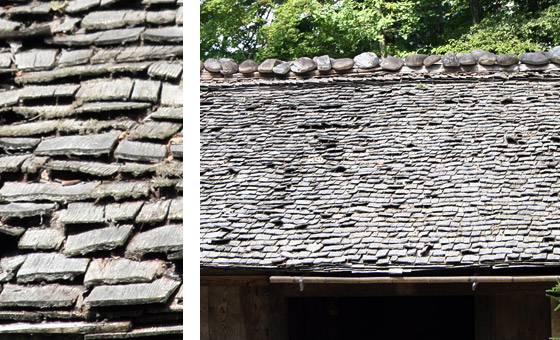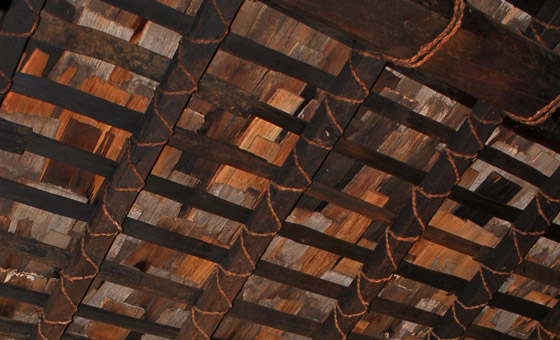Wood
shingles. Widely used in Japan for buildings of many kinds, ranging from palaces,
elite residences, shrines and temples to ordinary houses *minka
民家. Itabuki is believed to have been used at a high social level as early
as the Asuka period. On vernacular houses, it was particularly used
in mountainous areas where material for thatch was relatively hard to obtain.
In urban districts it was gradually displaced during the last years of the Edo
period by tile, which was both fireproof and longer lasting (itabuki roofs
lasted about 30 years). Generally, the shingles were made from a log split first
into quarters along the grain, and then cut or split (with wedges or a hatchet
nata 鉈) into progressively thinner boards. These were less than 75mm thick,
and their width was less than three times their thickness. The preferred materials
were cedar *sugi 杉, sweet chestnut
kuri 栗 and chamaeciparis pisifera sawara 椹. Reddish, sinuous lumber
was preferred. Shingle types, in declining order of quality, included: tochi
栩, tokusa 木賊, masa 柾, koba 木羽, and kokera 柿. It is
clear from a comparison of early medieval itabuki on vernacular houses,
as depicted in illustrated handscrolls *emaki
絵巻, and itabuki shown in late Muromachi to Momoyama period painted screens
*byoubu-e 屏風絵, that there
was a general tendency for the shingles to get smaller. In the late Heian period,
the distance from ridge to intermediate pillars *irigawabashira
入側柱, and from intermediate pillars to outer pillars *kawabashira
側柱 were each spanned with a single long shingle. In the Momoyama period, four
or five shingles seem to have been enough to cover the distance from ridge to
eaves, suggesting that the length of individual shingles was reduced by half.
By the later Edo period, large shingles averaged between 45-85cm in length by
9-15cm in width by 1cm thick, while small ones averaged 30cm in length by 12cm
in width by 3mm thick. Roofing undertaken with the larger type is called *naga-itabuki
長板葺, and with the smaller, ko-itabuki 小板葺. Doubtless dwindling timber resources
led to this diminution in size. From medieval times, however, small shingles came
to be used in more refined itabuki roofs on elite residences, shrines,
and presumably developed to simulate the effects of cypress-bark roofing *hiwadabuki
桧皮葺. In these roofs, the lap of the shingle courses was far greater. A variety
of names were used for such roofs, according to the detail and the type and thickness
of the single, but the best known are *tochibuki
栩葺 and *kokerabuki 柿葺.
Other forms of itabuki include sogibuki 殺ぎ葺, noshibuki 熨斗葺, *yamatobuki
大和葺, *odawarabuki 小田原葺,
tontonbuki とんとん葺 and *ishioki
itabuki 石置板葺. The character of itabuki roofs varied from the most
curvaceous elegance possible, kokerabuki, which could be used for nearly
any shape of roof, to the straight, shallowly pitched roofs of ishioki itabuki
houses, which were almost invariably gabled *kirizuma yane
切妻屋根. Fixings as well as shingle size had much to do with this contrast: kokerabuki
shingles were held in place with bamboo nails, while ishioki itabuki was
held in place with stones. Roofs could not be steep or the stones would roll off.
|




